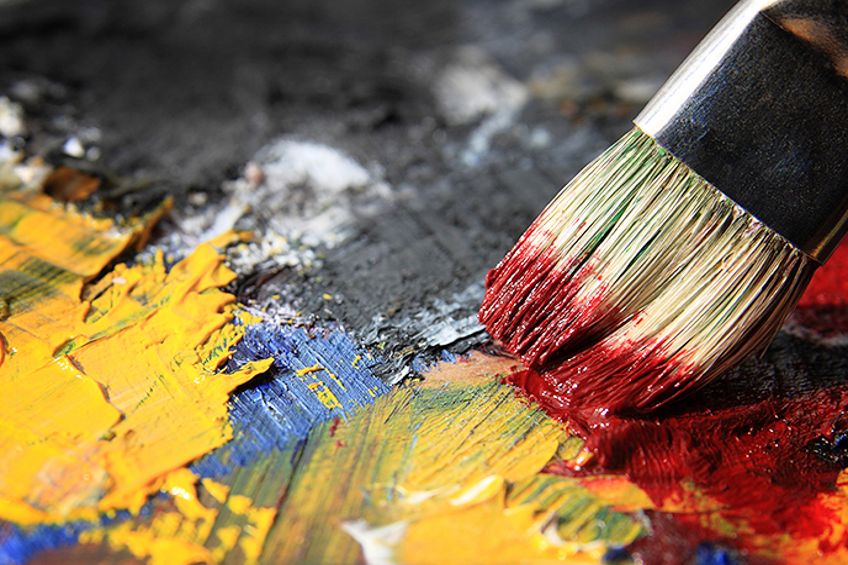How Long Does Oil Paint Take to Dry? – Oil Paint Drying Times
This post may contain affiliate links. We may earn a small commission from purchases made through them, at no additional cost to you.
When it comes to oil paints, they certainly have a reputation for being excruciatingly slow to dry. This medium has the longest drying time compared to other paint mediums like watercolors and acrylics. For this article, we are going to discuss oil paint drying times as well as how to make oil paint dry faster.
Table of Contents
How Long Does Oil Paint Take to Dry?
Firstly, this will depend on the product or brand of oils you are using. Most oil paints are workable on your palette or canvas for up to eight hours before they start to harden. Being dry and being dry to the touch are two different things, however. Your oil paints will need to be left for at least 24 hours before they will be touch-dry. Again, this is not set in stone and your paint drying times will depend on the thickness and layers of oils that have been applied.
Here, we will look at the different factors that directly influence your oil paint drying times.
Your Color Pigments
Your oil paint drying times can also vary from color to color. Some pigments are naturally thicker and will therefore take a bit longer to dry. If you are able to maintain a consistent paint application where you are achieving coverage without over-saturating the area, your painting should be dry within a day.
Using earth tones and oil paints that are made with iron oxides will naturally dry faster than others. This includes your browns, reds, and orange shades. Going for brands or colors that make use of cobalt and lead within their oil paints is also beneficial to the drying time. The colors you want to steer away from when trying to do a quick painting would be using thick blacks, whites, and yellows.
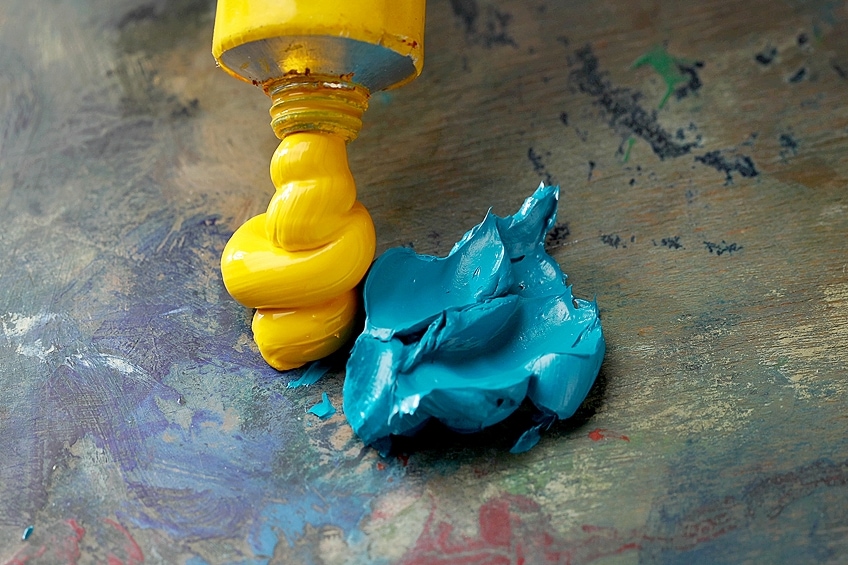
Paint Quality and Brand
As with any product, the brand used is useful in determining the quality of the paint. Some brands offer more entry-level or beginner-grade oil paints that may be of a lesser quality than the professional ranges. This is why it is helpful to look at product reviews before purchasing any paint medium. This process will help in getting a better idea of others’ experiences and what they feel the product may be lacking compared to others.
All oil paints are made using oil as a base, althoughwhich one is used will vary based on the brand and their manufacturing process. When looking at product recommendations, it is helpful to see what oil medium that brand has used, as this will directly impact your oil paint drying times.
Painting Techniques
Another factor that can influence your drying time is that of the painting techniques used. Many oil painting techniques like to make use of thick brush strokes, bold textures, and bright colors. These techniques, such as impasto or fresco, will take a few days if not a week to properly cure. This is due to your needing to wait for your layers to dry before continuing with the next.
Of course, using a quick technique such as alla prima will yield fast results in one sitting. Painting “wet on wet” means adding colors and layers on top of each other without waiting for the previous ones to dry first.
Environmental Factors
Your painting environment is important, especially when using a medium such as oils. These paints are very sensitive to environmental factors such as heat, moisture, humidity, and direct sunlight, not to mention dust and dirt too. When your painting is drying, it is best kept on an easel or even hung on the wall. This will keep it safe and protected until you can apply a varnish or frame.
Once you are done painting and have left it for about a week to dry, your painting will still not be dry enough to frame. This is what makes oils so time-consuming; framing or sealing your painting can only be done after six months to a year of completing your work. Adding a glass frame or fixative over your work before that may result in smudging and damage to your paint.
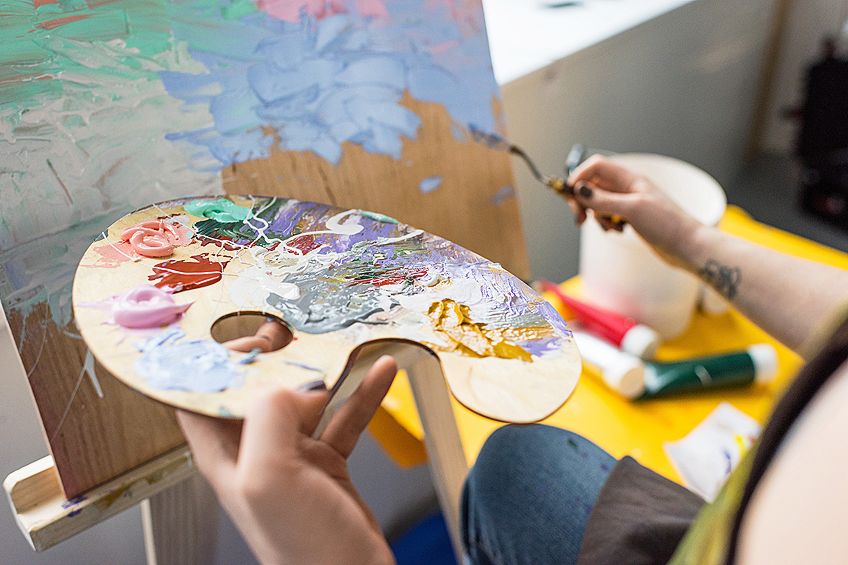
Being highly sensitive to temperature, oil paints tend to work better when they are cold. Painting in colder weather will often yield better results than using oils in hot or humid weather. Some artists even go so far as to store their paints in the freezer when not in use. This is because oils do not freeze in temperatures warmer than negative 20 degrees Fahrenheit (-28 degrees Celsius).
So, using your home freezer would never be cold enough to freeze your paints, but will assist them in retaining moisture when using for a few days in a row. This is not a viable long-term solution for storing your paints, but it works well enough that you do not waste paint already out the tubes. This way, your oils are kept in an ideal temperature overnight so you can pick up where you left off tomorrow. This will ensure that they are still workable and will not go to waste.
Now that we know why oil paints take so long to dry, let us take a look at how to improve that.
How to Make Oil Paint Dry Faster
If you would like to speed up or perhaps even slow down your drying time, this can be done with the use of oil paint mediums. These tools are combined with your oil paints to alter their consistency, fluidity, colors, and drying time. When painting with oils, many artists prefer to use both a solvent and an oil medium. This is because they each have their own functions and can collaborate nicely when it comes to your oils. Let us take a look at the various oil mediums available.
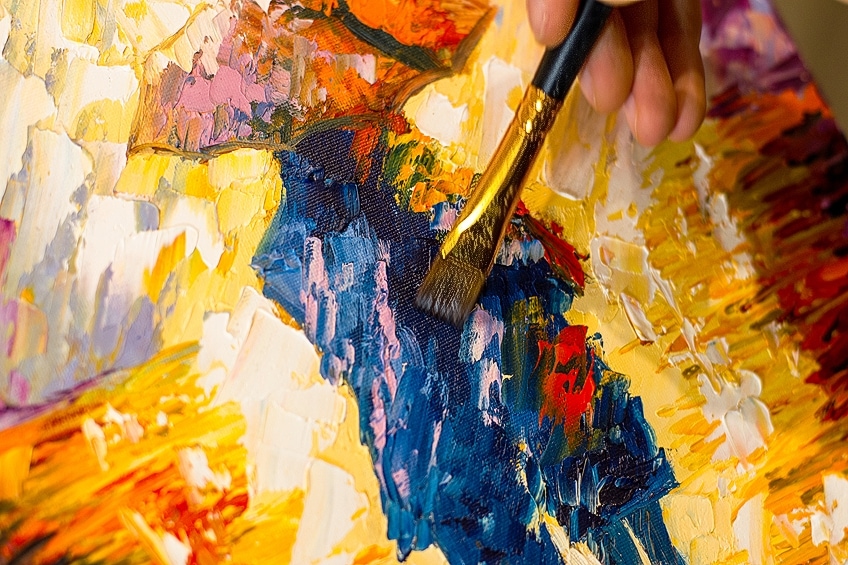
Solvents and Thinners
- These are chemicals used to thin your oil paints, making them dry faster. Solvents are great for techniques like creating washes or underpainting. These mediums dilute your oil paints and can wash out your color pigments too.
- Solvents and thinners are also useful in your brush cleaning process. These chemicals will strip the paint from your brushes and remove any messes from your surfaces too. Although you should never leave your paintbrushes to soak in chemicals for long periods, as this will lead to deterioration.
- For those who are sensitive to harsh smells, there are odor-free solvent medium options available.
Non-Toxic Solvents
- These are natural alternatives that work in the same way as chemical solvents, but without the harmful chemicals. One example would be that of citrus-based oil mediums, which contain high concentrations of citrus oils and water. The high acidity in the fruits acts as a natural solvent, which is also helpful in cleaning oils off other surfaces and brushes.
- Another natural alternative is spike lavender oil, which has been used for centuries. Aside from the calming scent, this works well as an oil paint medium.
Oil-Based Mediums
- These are some of the oils that your oil paints are made of. They include linseed, walnut, poppyseed, and safflower. Oil mediums are natural and therefore safer to use without the strong smell.
- These are useful in techniques where one requires gloss, or thick strokes and textures. Adding oil mediums to your paints will either assist in drying time or lengthen it, depending on the oil you choose.
- Using oil mediums is beneficial when cleaning your paintbrushes too. These natural oils condition and moisturize your bristles from the inside, leaving them soft and clean every time.

Alkyd Mediums
- Alkyd mediums are a common option for speeding up your drying time when using oils. They are made with a resin that acts quickly to firm and harden your paint within a few hours.
- Alkyds also add a glossy finish to your work. Using these mediums will eliminate your use of an oil or solvent when painting.
- Usually, they come in two options: Liquin, which is more fluid and allows for better workability, and then there is also the gel option, which adds transparency to colors and maximizes the flow of your paints.
Gesso and Primer
- These are used before you start painting to coat your canvas or other surface option. Using a primer or a pre-primed canvas creates a porous layer for your oils to stick to for better coverage and future durability.
- Acrylic gesso is a good medium for priming your surface when painting with oils. The key is to apply up to three even coats to your surface, allowing each one to dry in-between.
As you can see, there are many different oil paint mediums available, each one with its own benefits and purpose. Because natural oils are more commonly used, let us take a closer look at these individually.
Using Oil Mediums for Drying Oil Paint
Here is a summary of the different drying times when using oil mediums, so that you know which would work best for you:
- The slowest drying oil medium to use would be poppyseed oil. This coats your paints and brushes, allowing a wetter look and feel for extending your paint time. Poppyseed oil can be used to add fluidity and gloss to your work as well as to clean your brushes.
- Safflower and walnut oils are both slower drying oil paint mediums that will not assist in a quick drying time. Like poppyseed oil, these two options are also very thick and not as fluid as the other oil options.
- If you are looking to increase drying time, then you would use an alkyd medium, linseed oil, or chemical solvent. These work by thinning your paints and making them more workable for an even application, creating a significant increase in drying time.
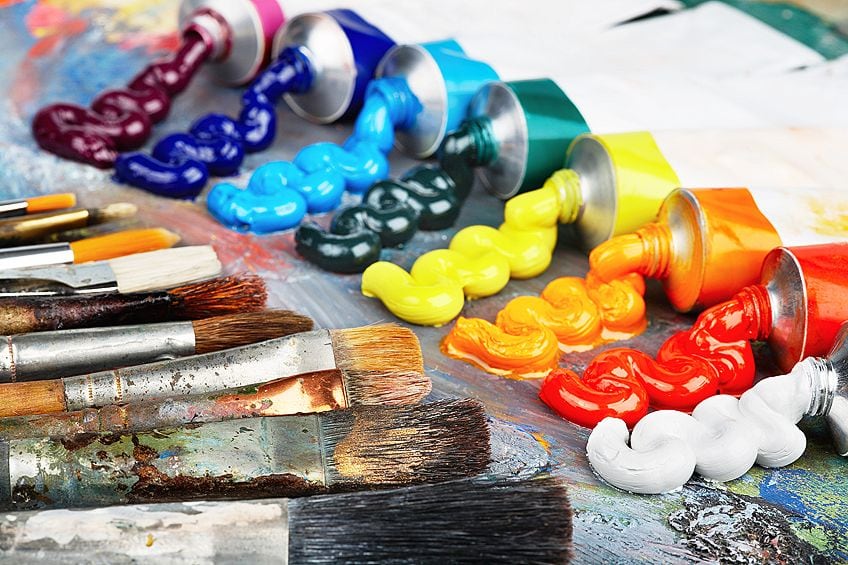
How to Make Oil Paint Dry Faster at Home
Aside from the use of oil or chemical paint mediums, here are some simple tips you can do at home to improve your oil paint drying times.
- The easiest thing to do is to leave your finished painting in a well-ventilated area with ample natural light. You can also make use of a fan or a dehumidifier in more humid conditions to increase the airflow.
- Although oil paints tend to dry better in a warmer environment, they will not do well if left directly in the sun. The perfect room temperature for drying your oil paintings would be 70 degrees Fahrenheit (21 degrees Celsius).
- Before starting your painting, applying a primer or gesso layer is always useful. This coats your canvas to make it more porous, allowing your oils to properly adhere to the surface. Some oil-specific canvases already come pre-primed.
- Before jumping in with your oil paints, it may be useful to first apply your underpainting or a base coat using acrylics. These are much quicker to dry than oils, and you can then use your oil paints to build up layers and add in color and texture.
- Be mindful of the color palette you are using. Earth tones or paints that contain mineral pigments will naturally dry quicker.
- When painting, it is helpful to use thinner layers. Applying more controlled and finer layers of paint will often result in a quicker dry time. Making your layers too thick will result in your painting seeming dry on the surface, but then still being wet to touch even after long periods. This is because oils naturally dry from the top layer down, meaning your first layers can stay wet for weeks or even months.
- Using a heat gun has been known to assist in drying your oils when you have a deadline. These tools will essentially bake your painting, allowing it to dry faster. However, these should be used with caution. Extreme temperatures can damage your painting and cause cracking or yellowing. For the best results, your gun should be held a small distance from your painting and should not be hotter than 130 degrees Fahrenheit (54 degrees Celsius).
- Do not attempt to frame or varnish your painting before waiting at least six months after completion.
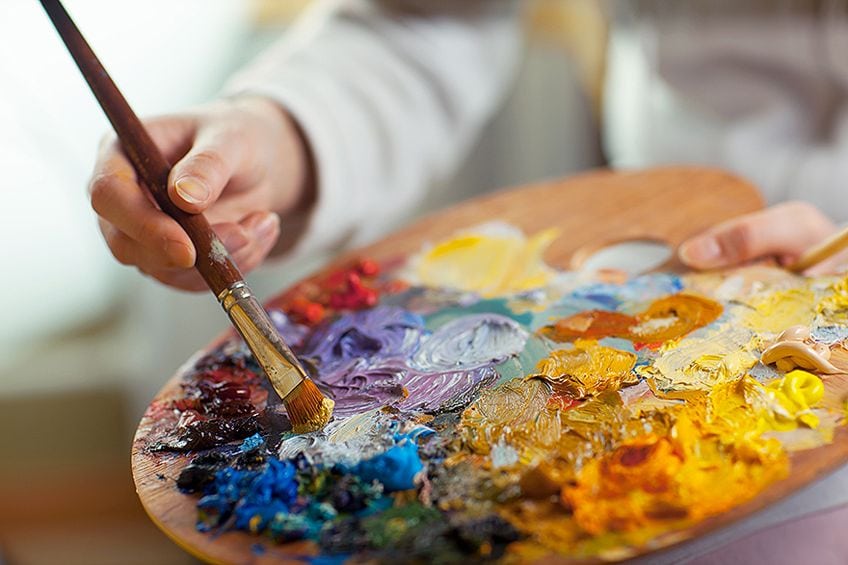
Checking Whether Your Oil Painting Is Dry
If you are anxiously waiting for your work to dry, there is an easy way to check it without damaging your painting. After at least 18 hours, you can gently glide your finger or nail over a small section of work. You should notice some fine dust or powder that gently comes away when you do this. That indicates that your layers are dry enough to continue with. Be sure to do this very lightly so as not to damage your canvas.
Now we know the ins and outs of why oil paint takes so long to dry and how to make your oil paints dry faster. We hope you enjoy experimenting with all these mediums and techniques.
Frequently Asked Questions
How Long Does Oil Paint Take to Dry?
Being oil-based, oil paints naturally take longer to dry. Depending on the thickness of your paints, the layers used, and the brand, an average painting can take up to 24 hours to be dry to the touch.
How Long Before You Can Frame your Oil Painting?
Oil paintings are composed of many layers of thick paint. They do not dry the same way other paints do, as oil paints react to the air and oxidize and cure. Because of this, they tend to dry from the top layer down, taking much longer. You should wait a minimum of 6 months to a year before framing or varnishing any oil work.
How to Make Your Oil Paints Dry Quicker?
There are many mediums you can use while painting to either quicken or slow down your drying time. These include solvents, oils, and alkyds. The medium you choose will determine the outcome of your painting.
Larissa Meyer is a 32-year-old mother from Michigan and creative spirit since childhood. Her passion for painting and drawing has led her to an education as an illustrator and a career as a freelance graphic designer. She has a Bachelor of Fine Arts in Illustration and a degree in Graphic Design. Larissa is a talented artist who is able to master a wide range of styles and techniques to bring her artistic vision to life. Her greatest passion is currently fluid painting and epoxy resin art. Larissa’s love for art and her knowledge and experience in illustration make her the perfect Creative Director for our fluid-painting.com team. She is the creative head of our team and shares her passion and knowledge with our community through articles and tutorials.
As a mother of a 2-year-old daughter, Larissa also understands the importance of fostering creativity in early childhood. She uses her experience and knowledge to help other parents inspire their children and develop their artistic skills as well.
Learn more about Larissa Meyer and about us.

